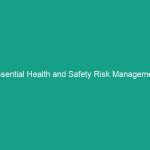Good Morning Team!
Today, we are diving into a crucial topic that directly affects our Workplace Safety: Critical Communication Breakdown Examples: Case Studies You Must Know. Understanding how communication failures can impact our Safety protocols is vital for fostering a secure and efficient work Environment.
By discussing real-world case studies, we can recognize the importance of clear communication and learn from others’ mistakes. This will not only enhance our Safety practices but also ensure that everyone goes home safely at the end of the day.
Understanding Critical Communication Breakdown
Critical communication breakdown refers to failures in the communication process that can result in misunderstandings, mistakes, and ultimately, safety incidents. It’s essential to recognize that effective communication is the backbone of any successful safety program.
These breakdowns can occur at various levels—between management and employees, among team members, or even during shifts. Miscommunication can lead to dangerous situations, such as equipment malfunctions or unsafe work practices.
Common misconceptions about communication breakdowns include the belief that they only occur due to language barriers or lack of Training. However, even seasoned professionals can misinterpret instructions or overlook important safety information if communication is not clear and concise.
Key Hazards, Risks, and Safety Considerations
Every workplace has its unique risks, but communication breakdowns can exacerbate these Hazards. Here are some critical areas to consider:
- Misinterpretation of Safety Protocols: When safety instructions are not conveyed clearly, employees may misunderstand Procedures, leading to unsafe practices.
- Lack of Feedback Mechanisms: Failure to implement a system for feedback can result in unresolved issues and recurring mistakes.
- Inadequate Training: Employees may not fully grasp safety procedures if training is insufficient or poorly communicated.
The consequences of ignoring these communication breakdowns can be severe. For instance, in 2016, a manufacturing facility experienced a serious accident when a worker misunderstood a safety alert due to unclear instructions, resulting in a critical injury. This incident could have been avoided with better communication practices.
Best Practices, Procedures, & Actionable Advice
To ensure effective communication and avoid breakdowns, here are some Best Practices to implement:
1. Use Clear and Concise Language
Always articulate safety instructions in straightforward language. Avoid jargon that may confuse team members. For instance, instead of saying, “Ensure the PPE is donned correctly,” say, “Put on your gloves and helmet before starting work.”
2. Implement Regular Safety Briefings
Hold regular Toolbox Talks to discuss safety protocols and encourage open dialogue. Make these sessions interactive to ensure everyone understands their roles and responsibilities.
3. Foster a Culture of Feedback
Create an environment where employees feel comfortable sharing concerns or asking questions. Encourage them to speak up when they notice potential safety issues.
4. Use Visual Aids
Visual aids such as signs, diagrams, and checklists can enhance understanding. For example, a color-coded hazard chart can help employees quickly identify risks in their environment.
5. Share Case Studies
Discuss past incidents as a team to analyze what went wrong and how communication could have been improved. For instance, a construction site faced a fatal accident when a crew member failed to communicate a tool malfunction, leading to a chain reaction. Learning from these events can prevent future occurrences.
Regulations, Standards, and Compliance
Compliance with safety Regulations is not just about following rules; it also involves ensuring effective communication. Here are some essential regulations to be aware of:
- OSHA Standards: The Occupational Safety and Health Administration mandates that employers communicate hazards to employees effectively.
- ISO 45001: This international standard for Occupational Health and safety emphasizes the importance of communication and consultation in safety management.
Adherence to these standards helps protect employees and fosters a culture of safety. Non-compliance can lead to severe penalties and, more importantly, put lives at risk.
Employee Engagement & Discussion
Now that we’ve covered the importance of communication in Workplace Safety, let’s engage in a discussion. Here are some questions to think about:
- What safety challenges have you encountered related to communication?
- Can you share an example of a time when clear communication made a difference in your safety practices?
- What suggestions do you have for improving our communication regarding safety protocols?
Feel free to share your thoughts or experiences. This is a safe space for open dialogue, and your input is invaluable in improving our Workplace Safety.
Conclusion & Key Takeaways
To wrap up, effective communication is critical to maintaining a safe work environment. By understanding the implications of communication breakdowns and implementing Best Practices, we can significantly reduce risks and enhance our safety protocols.
Remember, safety is a shared responsibility, and clear communication is a key component. Let’s commit to prioritizing effective communication in our daily operations.
Thank you for your attention today, and for your ongoing commitment to Workplace Safety. Together, we can create a safer environment for everyone.


